Optics | Physics - Prism | 12th Physics : UNIT 6 : Ray Optics
Chapter: 12th Physics : UNIT 6 : Ray Optics
Prism
PRISM
A prism is a triangular block of glass or plastic. It is bounded by the three plane faces not parallel to each other. Its one face is grounded which is called base of the prism. The other two faces are polished which are called refracting faces of the prism. The angle between the two refracting faces is called angle of prism (or) refracting angle (or) apex angle of the prism represented as A as shown in Figure 6.40.
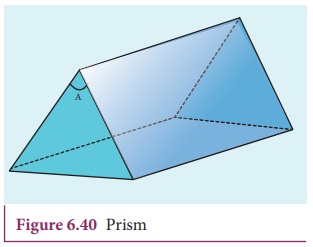
Angle of deviation produced by prism
Let light ray PQ is incident on one of the refracting faces of the prism as shown
in Figure 6.41. The angles of incidence and refraction at the first face AB are i1 and r1.
The path of the light inside the prism is QR.
The angle of incidence and refraction at the second face AC is r2 and i2 respectively. RS is the
ray emerging from the second face. Angle i2
is also called angle of emergence. The
angle between the direction of the incident ray PQ and the emergent ray RS is
called the angle of deviation d.
The two normals drawn at the point of incidence Q and emergence R are QN and RN. They meet at point N.
The incident ray and the emergent ray meet at a point M.

The deviation d1 at the surface AB is,
In the quadrilateral AQNR, two of the angles (at the vertices
Q and R) are right angles. Therefore, the sum of the other angles of the
quadrilateral is 180º.
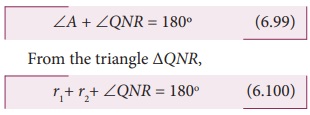
Comparing these two equations (6.99)
and (6.100) we get,

Substituting this in equation (6.98)
for angle of deviation,

Thus, the angle of deviation depends
on the angle of incidence angle of emergence and the angle for the prism. For a
given angle of incidence the angle of emergence is decided by the refractive
index of the material of the prism. Hence, the angle of deviation depends on
these following factors.
(i) the
angle of incidence
(ii) the angle of
the prism
(iii) the material
of the prism
(iv) the wave length of the light
EXAMPLE 6.19
A monochromatic light is incident on
an equilateral prism at an angle 30º and emerges at an angle of 75º. What is
the angle of deviation produced by the prism?
Solution
Given, as the prism is equilateral,
A = 60°; i1 = 30°; i2
= 75°
Equation for angle of deviation, d = i1
+ i2 – A Substituting the values, d = 30°+75°–60°=45° The angle of deviation produced is, d = 45°
EXAMPLE 6.20
Light ray falls at normal incidence
on the first face of anequilateral prism and emerges gracing the second face.
What is the angle of deviation? What is the refractive index of the material of
the prism?
Solution
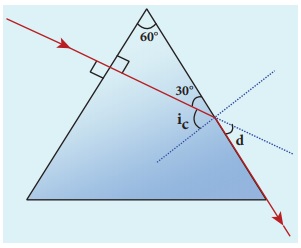
The given situation is shown in the
figure.
Here, A = 60°; i1 =
0°; i2 = 90°
Equation for angle of deviation,
d = i1 + i2
− A
Substituting the values,
d = 0°+ 90°−60° = 30°
The angle of deviation produced is, d = 30°
The light inside the prism must be
falling on the second face at critical angle as it graces the boundary.
Equation for critical angle is, sinic = 1/n
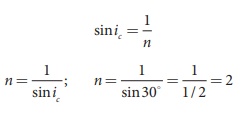
The refractive index of the material
of the prism is, n = 2
Angle of minimum deviation
A graph plotted between the angle of
incidence and angle of deviation is shown in Figure 6.42. One could observe
that the angle of deviation decreases with increase in angle of incidence and
reaches a minimum value and then continues to increase.

The minimum value of angle of
deviation is called angle of minimum
deviation D. At minimum deviation,
(a) the angle of
incidence is equal to the angle of emergence, i1=i2.
(b) the angle of
refraction at the face one and face two are equal, r1=r2).
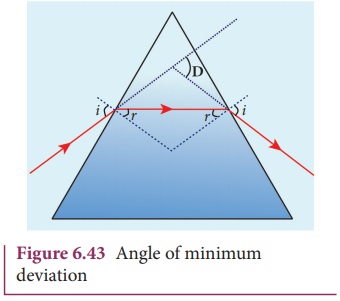
(c) the incident ray and emergent
ray are symmetrical with respect to the prism.
(d) the refracted ray inside the
prism is parallel to its base of the prism.
The case of angle of minimum
deviation is shown in Figure 6.43.
Refractive index of the material of the prism
At minimum deviation,
i1=i2=i and r1=r2=r
Now, the equation (6.102) becomes,
D = i1 + i2 - A
= 2i − A
(or)
i = (A + D) / 2
The equation (6.101) becomes,
r1 + r2 = = A ⇒ 2r = A
(or)
r = A/2
Substituting i and r in Snell’s law,
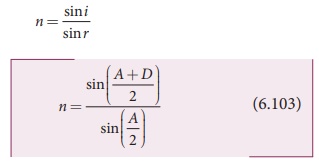
The above equation is used to find the
refractive index of the material of the prism. The angles A and D can be measured
experimentally.
EXAMPLE 6.21
The angle of minimum deviation for a
prism is 37º. If the angle of prism is 60º, find the refractive index of the
material of the prism.
Solution
Given, A=60°; D=37°
Equation for refractive index is,
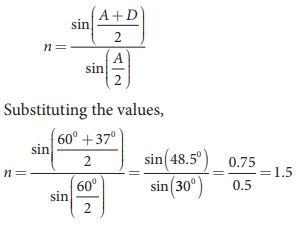
The refractive index of the material
of the prism is, n = 1.5
Dispersion of white light through prism
So far the angle of deviation
produced by a prism is discussed for monochromatic light (i.e. light of single
colour). When white light enter in to a prism, the effect called dispersion takes place. Dispersion is splitting of white light into
its constituent colours. This band of colours of light is called its spectrum. When a narrow beam of
parallel rays of white light is incident on the face of a prism and the
refracted beam is received on a white screen, a band of colours is obtained in
the order, recollected by the word: VIBGYOR i.e., Violet, Indigo, Blue, Green,
Yellow, Orange and Red. Violet is the most deviated and red is the least
deviated colour as shown in Figure 6.44.
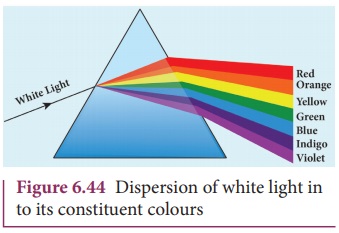
The colours obtained in a spectrum
depend on the nature of the source of the light used. Each colour of light is
associated with a definite wavelength. Red light is at the longer wavelength
end (700 nm) while the violet light is at the shorter wavelength end (400 nm).
Therefore the violet ray travels with a smaller velocity in glass prism than
red ray.
Points to Ponder
Sir Isaac Newton has demonstrated
through a classic experiment to produce white light when all the colours of
VIBGYOR are recombined. He used a prism to produce dispersion and made all the
colours to incident on another inverted prism to combine all the colours to get
white light as shown in figure.
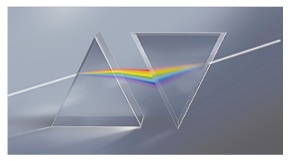
Dispersion takes place because light
of different wave lengths travel with different speeds inside the prism. In
other words, the refractive index of the material of the prism is different for
different colours. For violet, the refractive index is high and for red the
refractive index is the low. In Vacuum, all the colours travel with the same
speed. The refractive index of two different glasses for different colours is
shown in Table 6.4.
The speed of light is independent of
wavelength in vacuum. Therefore, vacuum is a non-dispersive medium in which all
colours travel with the same speed.
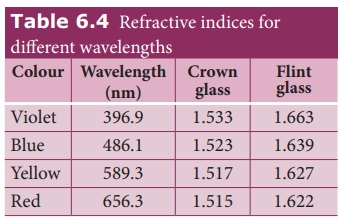
Dispersive Power
Consider a beam of white light
passes through a prism; it gets dispersed into its constituent colours as shown
in Figure 6.45. Let δV, δR are the angles of
deviation for violet and red light. Let nV
and nR are the
refractive indices for the violet and red light respectively.
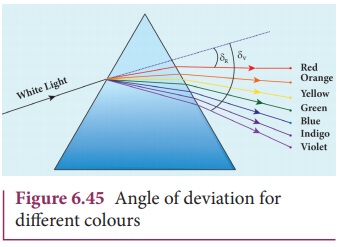
The refractive index of the material
of a prism is given by the equation (6.103),

Here A is the angle of the prism and D
is the angle of minimum deviation. If the angle of prism is small of the
order of 10º, the prism is said to be a small angle prism. When rays of light
pass through such prisms, the angle of deviation also becomes small. If A be the angle of a small angle prism
and δ the angle of deviation then the
prism formula becomes.
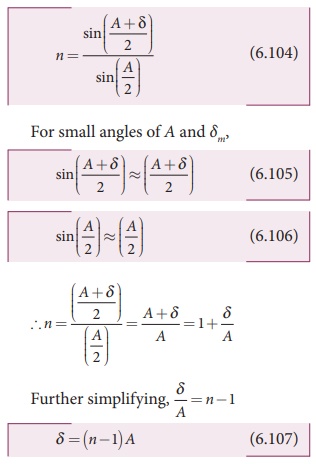
When white light enters the prism,
the deviation is different for different colours. Thus, the refractive index is
also different for different colours.

As, angle of deviation for violet
colour δV is greater than
angle of deviation for red colour δR,
the refractive index for violet colour nV
is greater than the refractive index for red colour nR.
Subtracting δV from δR
we get,

The term (δV–δR) is the angular separation
between the two extreme colours (violet and red) in the spectrum is called the angular dispersion. Clearly, the angular dispersion produced by a prism depends
upon.
(i) Angle of the
prism
(ii) Nature of the material of the
prism.
If we take δ is the angle of deviation for any middle ray (green or yellow)
and n the corresponding refractive
index. Then,

Dispersive power (ω) is the ability of the material of the
prism to cause dispersion. It is defined as the ratio of the angular dispersion
for the extreme colours to the deviation for any mean colour.
Dispersive power (ω),

Dispersive power is a dimensionless
quality. It has no unit. Dispersive power is always positive. The dispersive
power of a prism depends only on the nature of material of the prism and it is
independent of the angle of the prism.
EXAMPLE 6.22
Find the dispersive power of flint
glass if the refractive indices of flint glass for red, green and violet light
are 1.613, 1.620 and 1.632 respectively.
Solution
Given, nV=1.632; nR=1.613;
nG=1.620
Equation for dispersive power is,
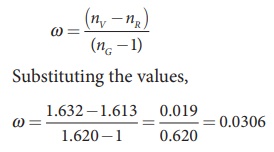
The dispersive power of flint glass
is, ω = 0.0306
Scattering of sunlight
When sunlight enters the atmosphere
of the earth, the atmospheric particles present in the atmosphere change the
direction of the light. This process is known as scattering of light.
If the scattering of light is by atoms and molecules which have
size a very less than that of the
wave length λ of light a<<λ, the scattering is called Rayleigh’s
scattering. The intensity of Rayleigh’s
scattering is inversely proportional to fourth power of wavelength.

According to equation 6.114, violet colour which has the shortest wavelength gets much scattered during day time. The next scattered colour is blue. As our eyes are more sensitive to blue colour than violet colour the sky appears blue during day time as shown in Figure 6.46(a). But, during sunrise and sunset, the light from sun travels a greater distance through the atmosphere. Hence, the blue light which has shorter wavelength is scattered away and the less-scattered red light of longer wavelength manages to reach our eye. This is the reason for the reddish appearance of sky during sunrise and sunset as shown in Figure 6.46(b).
Rainbow is an example of dispersion
of sunlight through droplets of water during rainy days. Rainbow is observed
during a rainfall or after the rainfall or when we look at a water fountain
provided the sun is at the back of the observer. When sunlight falls on the
water drop suspended in air, it splits (or dispersed) into its constituent
seven colours. Thus, water drop suspended in air behaves as a glass prism.
Primary rainbow is formed when light entering the drop undergoes one total
internal reflection inside the drop before coming out from the drop as shown in
figure. The angle of view for violet to red in primary rainbow is 40º to 42º. A
secondary rainbow appears outside of a primary rainbow and develops when light
entering a raindrop undergoes two internal reflections. The angle of view for
red to violet in a secondary rainbow is, 52º to 54º.
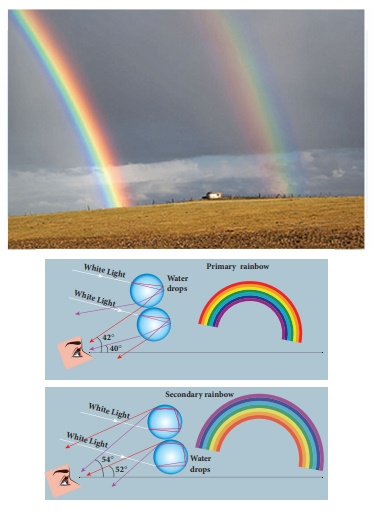
If light is scattered by large
particles like dust and water droplets present in the atmosphere which have
size a greater than the wavelength λ of light, a >> λ, the
intensity of scattering is equal for all the wavelengths. It is happening in
clouds which contains large amount of dust and water droplets. Thus, in clouds
all the colours get equally scattered irrespective of wavelength. This is the reason for the
whitish appearance of cloud as shown in Figure 6.46(c). But, the rain clouds
appear dark because of the condensation of water droplets on dust particles
that makes the cloud become opaque.
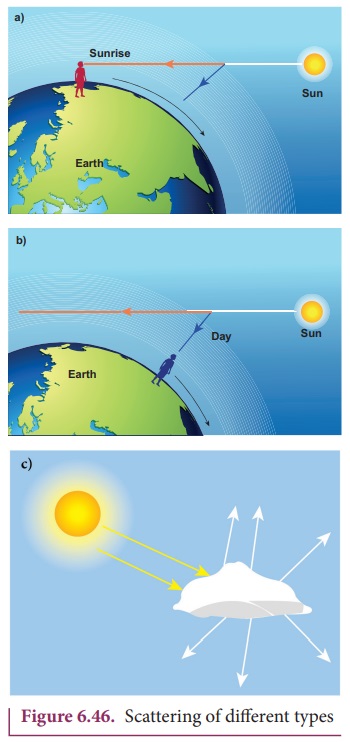
If earth has no atmosphere there
would not have been any scattering and the sky would appear dark. That is why
sky appears dark for the astronauts who could see the sky from above the
atmosphere.
Related Topics